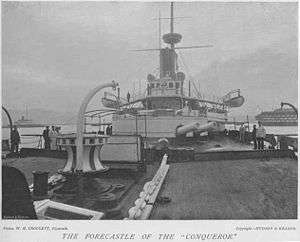HMS Conqueror (1881)
.jpg) HMS Conqueror as she appeared upon completion in 1886. | |
| History | |
|---|---|
| Name: | HMS Conqueror |
| Builder: | Chatham Dockyard |
| Laid down: | 28 April 1879 |
| Launched: | 8 September 1881 |
| Completed: | March 1886 |
| Fate: | Broken up 1907 |
| General characteristics | |
| Displacement: | 6,200 tons |
| Length: | |
| Beam: | 58 ft (18 m) |
| Draught: |
|
| Propulsion: |
|
| Speed: | 14 knots |
| Complement: | 330 men |
| Armament: |
|
| Armour: |
|
HMS Conqueror was an ironclad battleship of the Victorian Royal Navy, whose main armament was an armoured ram.
She was the first ship of the Conqueror class to be laid down, her only sister-ship being HMS Hero, which was completed some two years later. At the time of her design it was thought that ramming attacks were the most effective offensive manoevre against armoured warships, as the armour of the period was, for a short time, able to defend against the majority of contemporary guns extant. This belief was reinforced by the action at the battle of Lissa, when the Austrian battleship Ferdinand Max rammed and sank the Italian Re D'Italia. The Italian ship was at the time a stationary target, a detail which it appears did not receive, in naval architects' minds, the attention it deserved.

Conqueror's breech-loading guns were of 12-inch (305-mm) calibre, and were twenty-five calibres (25 feet) long. They fired a shell weighing 714 pounds (324 kg) with a muzzle velocity of 1,910 ft/second (582 m/second), and could penetrate 10 inches (254 mm) of armour if the shell struck at or near a ninety-degree angle; much less, however, in the much more likely event of an oblique impact. They were placed very near to the deck, and it was found that a discharge over the bow caused marked blast damage to the deck and associated fittings. Firing abaft the beam caused blast damage to the bridge and superstructure, so in practice the guns could only fire on the beam, through an arc of some 45 degrees. It is, of course, the case that the heavy artillery was only intended to be used against a target which had evaded a ramming attack, and was therefore on Conqueror's beam.
The smaller guns were intended for use against small targets which could evade the ram and were not worth using the heavy artillery for. The torpedo tubes - six was the greatest number carried to date by a battleship - were placed aft and were intended for use against a target placed by accident or design astern of Conqueror, when the main armament would be valueless.
Service history
She was commissioned on 5 July 1887 for the Jubilee Review. She went into reserve at Devonport, becoming tender to the gunnery school Cambridge in 1889. She took part in manoevres on six occasions, and was not otherwise ever out of sight of land. Captain Edward Harpur Bayly was appointed in command on 17 June 1902.[1] She paid off in July 1902, and remained swinging at anchor at Rothesay until being sold in 1907.
References
- ↑ "Naval & Military intelligence". The Times (36787). London. 6 June 1902. p. 11.
- Oscar Parkes, British Battleships ISBN 0-85052-604-3
- Conway, All the World's Fighting Ships IDSBN 0-85177-133-5
- D K Brown, Warrior to Dreadnought ISBN 1-86176-022-1